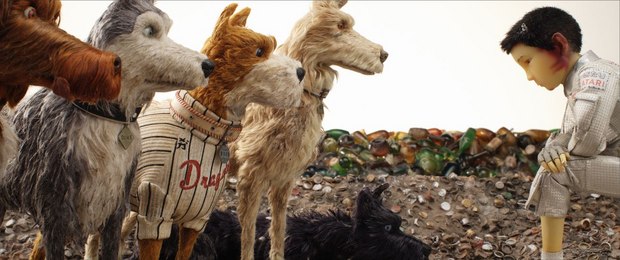Review: A Tale of Two Dogtoons – ‘Isle of Dogs’ and ‘Lady and the Tramp’
More than 60 years separate these animated films featuring Wes Anderson and Walt Disney’s very different takes on man’s best friend.
Saturday, February 17th: a day that will live in cartoon synchronicity.
It began as usual, with the latest page of my daily Disney calendar: a scene from Lady and the Tramp…and continued a few hours later with Lady and the Tramp arriving in my mailbox; to be precise, a screener of the “Walt Disney Signature Collection” Blu-ray, now available both digitally and a Multi-screen Edition.
The box’s cover illustration, the film’s eponymous dogs sharing that single spaghetti strand, is an iconic Disney moment. It’s been spoofed in everything from MAD magazine to Hot Shots Part Deux and Family Guy. While self-referential audience winks are all the rage these days, the closest Disney’s own Enchanted came to riffing on it was naming the restaurant where that film’s romantic couple dined “Bella Notte,” after the song accompanying the dogs’ dinner. (Unlike Part Deux however, no Enchanted noses engaged in meatball nudging.)
One of animation’s unique qualities is its ability to tell stories in stylized imagery live-action films are unable to replicate. In L&T there’s an inventive time-telescoping sequence where luminescent pink gridlines of a ghostly calendar merge into the backgrounds as the birth of “Jim Dear” and “Darling”’s baby approaches; elsewhere in the film the backgrounds behind Lady transform from cozy to dreary while Tramp describes the supposedly unpleasant life waiting for her once the baby is born.
Beginning with Snow White’s apple-induced narcolepsy and Pinocchio’s temporary demise via whale, the Disney features indulge in the trope so often it’s come to be known as “the Disney Death,” wherein a character believed to have perished is revealed to be alive after all. In the case of Trusty the bloodhound’s near-death experience in L&T, the calendar page I mentioned above revealed it was all Walt’s idea:
When Trusty chases the dogcatcher who’s carrying Tramp there’s an uncomfortable close call: after a terrible crash it seems like the end for Trusty. In truth he died in the original script, but Walt Disney gave the order: Trusty must live!
The Disney animated death is still with us. It was prominent in their animated Jungle Book where Baloo relishes hearing his own eulogy, in The Princess and the Frog where squished firefly Ray is reborn as a star and in Entangled when the supposedly doomed Flynn tells the audience, Sunset Boulevard-style, of his eventual supposed demise.
Thankfully, a different Hollywood trope, the “funny” ethnic stereotype, is all but extinct these days, but lives on in perennials like Lady and the Tramp when Tony, the heavily accented Italian restaurant owner serenades the mutt and cocker over dinner, or the slit-eyed, buck-fanged felines Si and Am who menacingly sing “We are Siamese if you please” while prowling Lady’s domicile. (They’re practically UN ambassadors of goodwill compared to Paul Winchell’s cringingly ching-chowy Siamese in The Aristocats.)
And where would animation be without gender stereotypes? Lady’s shaggy ears resemble a woman’s flowing locks while Tramp’s bushy moustache-y muzzle make it clear he’s a guy. If there’s any doubt, consider the sultry Peg, a Pekingese veteran of the “Dog and Pony” follies. Her sultry ballad “He’s a Tramp,” complete with a many a tail flourish and over-the shoulder winks leaves no doubt she’s still in heat, uh excuse me, still has the hots for the mongrel. (Fun fact: In 1988 Peggy Lee, who voiced Peg, Darling and the Siamese sued Disney for music royalties from the home video release and won $2.3 million for her troubles.)
 The widescreen movie’s Blu-ray image quality is immaculate of course, a disc any Disney completist will be proud to play on their 1080p screen (until they release the 4K version, that is…) Personally though what makes the Lady and the Tramp Blu-ray worth purchasing (if they hadn’t sent me a copy) are its supplemental features.
The widescreen movie’s Blu-ray image quality is immaculate of course, a disc any Disney completist will be proud to play on their 1080p screen (until they release the 4K version, that is…) Personally though what makes the Lady and the Tramp Blu-ray worth purchasing (if they hadn’t sent me a copy) are its supplemental features.
The L&T supplementals focus as much or more on Walt himself than the film itself. The features begin with “Walt and His Dogs,” essentially a visit to the Walt Disney Family Museum in San Francisco’s Presidio, an edifice intriguingly far, far away from the company’s southern California headquarters. Recordings of Walt’s canine-centric reminiscences are counterpointed with framed photographs of the future entertainment visionary (one of the very few people who actually deserve that accolade) in his turn-of-the-last-century youth. (We’re told the L&T scene where Jim Dear surprises wife Darling with a puppy in a hatbox was taken directly from Walt’s own life.)
Another feature reveals the secrets of Walt’s studio office, like its secret inner sanctum where he actually worked and an equally secret kitchen stocked with his favorite lunch, Spam. Daughter Diane shares a particularly fascinating anecdote: Walt had another secret; a live-in apartment above Disneyland’s Main Street firehouse. Not only did he recreate his Marceline Missouri childhood in Anaheim, he was able, almost as if in a Twilight Zone episode, to return there as well.
Unless you’re a foodie, feel free to skip the endless “how to make a meatball” cooking feature. (Although it’s loaded with factoids about the film, most of them can be found elsewhere on the disc).
The weirdest feature on the disc might be the “deleted” scenes. It’s a bit of a misnomer as the scenes in questions never got near the movie itself, never even made it past storyboard sketches.
At one point on the disc it’s commented Walt had been toying with the idea of doing a dog movie since 1936. I wonder if he might have been thinking of introducing Lady as the star of cartoon shorts, as two of those scenes are lengthy enough to stand on their own and would have likely brought a feature length narrative to a halt. In one, Lady disrupts a canine chorus line of exceptionally creepy-looking French poodles, and in a second, Boris, a pompous overpampered Russian wolfhound, tries to impress a very primitive version of Lady and her pal Homer. (Boris briefly appears in the finished film as an extra in the dog pound scene.)
 If Lady and the Tramp is set in a comforting small-town America of the past, Wes Anderson’s Isle of Dogs takes place “on the Japanese archipelago, twenty years in the future.” The corrupt, cat-loving mayor of Megasaki City has manufactured a supposed health crisis and ordered the city’s entire canine population exiled to the dystopic “Trash Island,” now known as the Isle of Dogs. A few months later the mayor’s twelve-year-old ward Atari crash lands on the island in search of “Spots,” his exiled best friend…
If Lady and the Tramp is set in a comforting small-town America of the past, Wes Anderson’s Isle of Dogs takes place “on the Japanese archipelago, twenty years in the future.” The corrupt, cat-loving mayor of Megasaki City has manufactured a supposed health crisis and ordered the city’s entire canine population exiled to the dystopic “Trash Island,” now known as the Isle of Dogs. A few months later the mayor’s twelve-year-old ward Atari crash lands on the island in search of “Spots,” his exiled best friend…
Simply put, even by Wes Anderson’s standards, Isle of Dogs is an amazing, inventive movie. It’s the director’s second stop-motion animated feature, a technique requiring attention to the tiniest detail—perfect for his controlled, deadpan style.
The film is replete with his trademark long-duration stationary camera shots and meticulous compositions. When Anderson is filming a set designed with severe, dead-ahead single-point perspective it’s inevitable the character entering the frame is going to wind up in its exact center, the perspective lines all converging directly on her. (By comparison, a shot of a canal stretching diagonally into the distance seems out of place in the film.)
Unlike a more conventional movie, Isle of Dogs’ Japanese humans don’t speak Japanese-accented English. When necessary their dialog is translated electronically or at public meetings by “Interpreter Nelson” (Frances McDormand, whose character ultimately finds herself emotionally caught up in the film’s events. Courtney B. Vance, the film’s portentous narrator does a lot of heavy lifting, plot-wise.) Quite considerately, the film provides a “note to viewers: all barks have been rendered into English,” plain old generic American English at that, even though they’re Japanese dogs; in fact, they have a hard time communicating with Atari even though they’ve lived in Japan all their lives. (“I wish somebody spoke his language,” one of the dogs complains.)
Isle of Dogs’ bemused take on Japanese culture is cleverly, slightly askew but affectionate at heart. (You can always tell the difference between parody based on fondness vs. contempt for the subject matter.) Witty touches abound, like a reproduction of Hokusai’s famous painting of crashing waves now brimming with cat-filled boats. The mayor is a stop-motion puppet, but on TV he appears as manga-style 2D animation.
Back in Megasaki City, American exchange student Greta Gerwig leads protests against Mayor Kobayashi, while on Trash Island a pack of dogs led by Rex (Edward Norton) protects Atari, “the little pilot”—but it’s the fierce loner Chief (Bryan Cranston) who, much to his surprise, finds a bond growing between himself and the young boy.
The near endless list of performers lending their voices to Isle of Dogs is utterly astonishing. The canine cast includes Liev Schreiber as the missing Spots, Bill Murray, Bob Balaban, Jeff Goldblum, F. Murray Abraham, Harvey Keitel, Tilda Swinton…and Angelica Huston as “Mute Poodle.” (On the human side of the cast, Yoko Ono appears as “Assistant-Scientist Yoko-Ono,” but barely gets a single line of dialog.) Even though the film stays away from Disney-level gender signifiers, it’s fairly obvious former show-dog Nutmeg is female, even before Scarlett Johannsson begins speaking as her.
An easily identifiable group scapegoated by those in power as a menace to society and people rising up to fight on their behalf? Isle of Dogs’ political undertones are unmistakable; like Black Panther’s T’Challa, who tells us we need to build bridges instead of barriers, or Zootopia’s heroes defeating a villain who claims “fear always works,” Isle of Dogs just might be part of a gathering zeitgeist that will set right a few things that have gone wrong lately.
And if nothing else, Isle of Dogs proves you can make a contemporary animated film about cartoon dogs completely free of fart jokes and butt sniffing.
![]() Joe Strike has written about animation for numerous publications. He is the author of Furry Nation: The True Story of America’s Most Misunderstood Subculture.
Joe Strike has written about animation for numerous publications. He is the author of Furry Nation: The True Story of America’s Most Misunderstood Subculture.

熱門頭條新聞
- The global GPU market is worth almost $100 billion.
- Submissions for 2025 Films are Open–ANNECY 2025
- Victura Introduces the World’s First Documentary Video Game
- Marvel Rivals Unveils Moon Knight Set to Join Launch Roster of All-Star Characters on December 6th
- A global business space for Latin American Animation projecting itself to the world
- Best Cinematography: The Digital Reign And Film’s Revival At The Oscars
- VIGAMUS IS EVOLVING: INTRODUCING GAMM – GAME MUSEUM
- Deadline of Reallusion’s 2024 Animation At Work Contest: January 7
